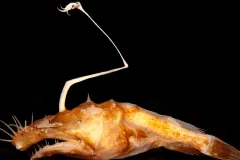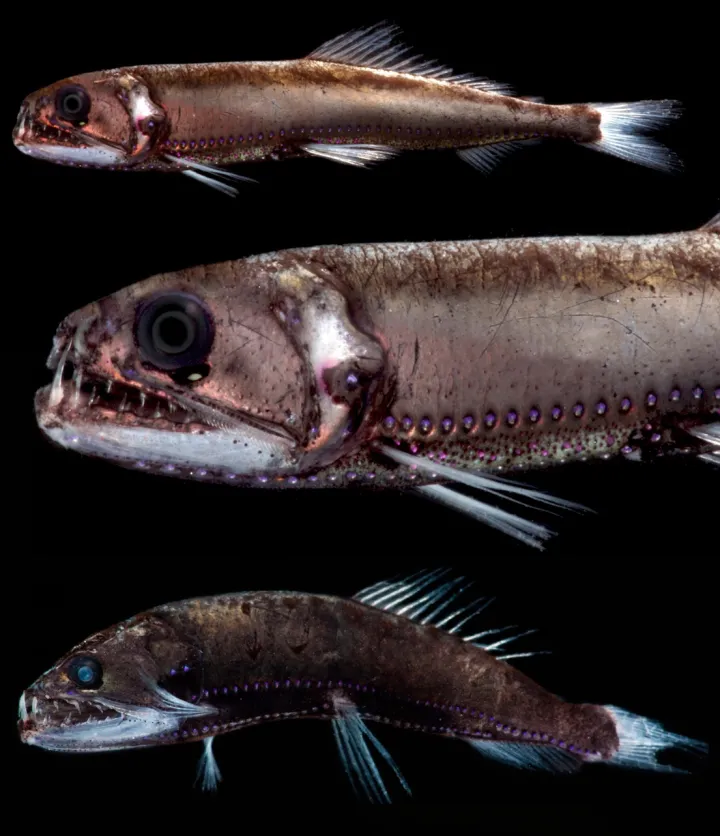The Gulf of Mexico: A Deep-Sea Treasure Trove of Fishes

Dragons, flying fish, and dreamers. These may seem like creatures from a fantasy world, but in fact, they are the names of fishes that live in a cold, deep, dark, and high-pressure ocean zone called the mesopelagic. At depths 650 to 3,300 feet (200 to 1,000 meters) beneath the surface, a trip to the mesopelagic is not an easy journey. For a while, scientists could hardly imagine that anything would live in such an extreme environment.
But it turns out the middle of the ocean is not a lifeless void as once thought. And the Gulf of Mexico’s mesopelagic zone is a particularly diverse body of water. So diverse that scientists recently described the Gulf as one of 33 unique mesopelagic areas around the globe (what they call ecoregions). The Gulf is also one of four mesopelagic regions deemed “super-diverse.”
Surveys conducted by the DEEPEND Consortium (a part of the Gulf of Mexico Research Initiative) in the years after the Deepwater Horizon oil spill found that there are roughly 800 fish species that live in deep Gulf waters—only three other deep places in the world can claim a similar number. One hundred and eighty of these fish were previously unrecorded in the region. There are even a few species that only live within the Gulf, like the snaggletooth dragonfish, a rarity—most mid-ocean animals are found throughout the globe.
“What astounds us over and over again is that we are still finding new species there all the time,” says Tracey Sutton, principal investigator of the DEEPEND Consortium and professor of marine and environmental sciences at Nova Southeastern University.
How is it that this region has so much diversity? It’s a combination of several factors, one of which has to do with its geography. The southern part of the Gulf sits in the Tropics, an area of the world that in general has a high level of diversity to begin with. But the Northern part of the Gulf also contains more temperate waters. This allows for both tropical and temperate species to live comfortably in the region. Also, with the open Atlantic and the Caribbean next door, species from these ecosystems can trickle in and thrive in the Gulf’s unique environment.
Changes in temperature in the Gulf add another boost of diversity. At the height of summertime, the surface waters of the Gulf can become super-hot, up to 93 degrees Fahrenheit (34 degrees Celsius), and in the winter, it can cool down to 64 degrees Fahrenheit (18 degrees Celsius). This seasonality creates a small disturbance to the ecosystem, which actually works to diversify the animals found in the system. The intermediate disturbance hypothesis is the scientific term for this idea—that a moderate amount of disturbance actually allows more species to live together.
In this particular instance, a shock of cold water allows species that prefer cooler temperatures to live in the Gulf while only the hardiest of the species that prefer warm temperatures can survive. Flip the shock of cold to a spike in temperatures and now only the hardiest of the cool water species survive. In a world of finite food sources, only a limited number of creatures can live in the mesopelagic. The spikes and dips in temperature allow both tropical and temperate species to take their share of the available energy rather than one dominating.
Finally, there’s the Mississippi River. Flowing at a rate of 600,000 cubic feet per second (the same amount of water as seven Olympic-sized swimming pools), the river spills into the Gulf, bringing nutrients like nitrogen and iron from further inland. In coastal waters, the nutrients can sometimes overwhelm the ecosystem, but strong currents also pull that water deep into the middle of the Gulf so that, “for a while you get these little pulses of nutrients that sprinkle some fertilizer on the system,” says Sutton. While many tropical waters lack nutrients that are necessary for animals to grow, the Mississippi adds just enough to help support the mid-water ecosystem.
While it’s understood that the Gulf is a unique habitat, it’s also understood there may be other places just as diverse as the Gulf yet to be discovered. Scientists have studied less than one percent of the world’s mid-water ecosystems and, according to Sutton, the Gulf is now probably the best studied mid-water habitat in the world.
“Here’s a region that we thought we knew a lot about and we went out there and found out, alright we didn’t know as much as we thought. What that tells you is how under sampled the whole of the world ocean is. We’re likely to find that anywhere we go,” says Sutton.
Future explorers will no doubt discover some amazing creatures, but for now, reveling in the Gulf’s diversity and the bizarreness of the snaggletooth dragonfish will have to do.
Editor's note: The Ocean Portal receives support from the Gulf of Mexico Research Initiative (GoMRI) to develop and share stories about GoMRI and oil spill science.
The Gulf of Mexico Research Initiative (GoMRI) is a 10-year independent research program established to study the effect, and the potential associated impact, of hydrocarbon releases on the environment and public health, as well as to develop improved spill mitigation, oil detection, characterization and remediation technologies. For more information, visit http://gulfresearchinitiative.org/.


